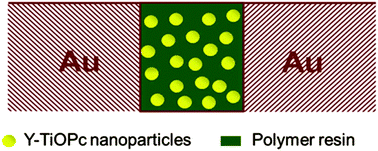A highly sensitive near-infrared organic photodetector based on oxotitanium phthalocyanine nanocrystals and light-induced enhancement of electron tunnelling†
Abstract
We report a photodetector working in accordance with the principle of light-induced enhancement of electron tunnelling through the junctions between photoconductor nanoparticles and an insulating polymer resin. Different from traditional multilayer organic photodetectors, the present one is composed of two metal electrodes and a polycarbonate film containing 20% of well dispersed Y-form oxotitanium phthalocyanine nanoparticles with an average diameter of 3.4 nm. The prepared photodetector exhibited a broad spectral response range with a red edge extending up to 940 nm and the highest external quantum efficiency of 356 (i.e. 35 600%) at a wavelength of 830 nm for organic photodetectors, suggesting the possibility of many applications based on near-infrared detection.


 Please wait while we load your content...
Please wait while we load your content...